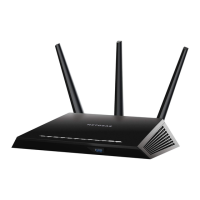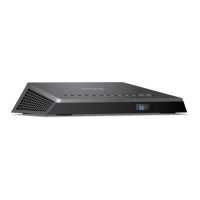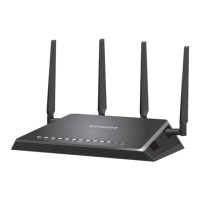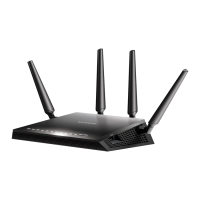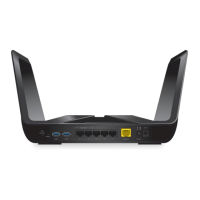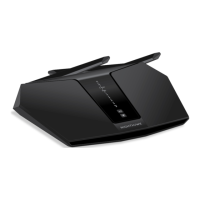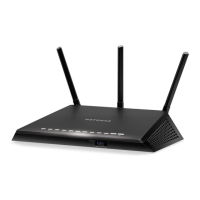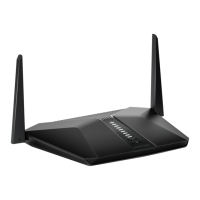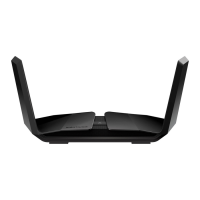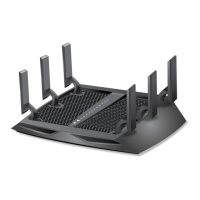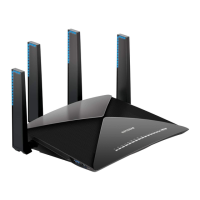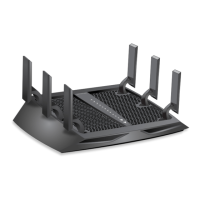Do you have a question about the NETGEAR NIGHTHAWK R7000 and is the answer not in the manual?
| WiFi Technology | 802.11ac |
|---|---|
| WiFi Performance | AC1900 (600 + 1300 Mbps) |
| WiFi Range | Very large homes |
| Processor | 1GHz Dual Core |
| Antenna | 3 external antennas |
| Beamforming | Yes |
| RAM | 256MB |
| Flash Memory | 128MB |
| Dimensions | 11.22 x 7.26 x 1.97 in (285 x 184.5 x 50 mm) |
| Ethernet Ports | 5 x 10/100/1000 Mbps Gigabit Ethernet ports (1 WAN & 4 LAN) |
| USB Ports | 1 x USB 3.0, 1 x USB 2.0 |
| Security | WPA2 |
| Weight | 1.65 lb (0.75 kg) |
Details on unboxing the router and its components.
Instructions for connecting and positioning the router antennas.
Description of LEDs and ports on the router's top and front.
Overview of connections and buttons on the router's rear panel.
Guidance on optimal placement for wireless signal range and performance.
Step-by-step instructions for connecting the router to the modem and power.
Instructions for establishing wired and wireless connections to the router.
Explanation of different login types: ISP, WiFi password, and router login.
Steps to access router settings via a web browser, including NETGEAR genie setup.
Procedure for logging into the router's web interface with default credentials.
Steps to change the router interface language from Auto to a specific language.
Guide to using the NETGEAR genie app for network management on mobile devices.
Walkthrough for automatically configuring internet settings using the Setup Wizard.
Detailed steps for manually configuring the router's internet connection settings.
Instructions for setting up connections requiring ISP login credentials like PPPoE.
Configuration options for various IPv6 internet connection types.
Procedure for adjusting the Maximum Transmission Unit (MTU) size for network optimization.
Using QoS to assign priority to gaming and streaming traffic.
Configuring upstream QoS to prioritize gaming traffic from devices like Xbox.
Creating custom rules for prioritizing specific applications or devices.
Enabling downstream QoS to prioritize video streaming traffic from sites like Netflix.
Enabling UPnP for automatic device discovery and network connection management.
Prioritizing wireless voice and video traffic using WMM QoS.
Configuring Live Parental Controls to filter internet content and manage access.
Setting up access control rules based on device MAC addresses.
Blocking specific websites or domain names using keywords.
Blocking specific internet services or applications based on type or schedule.
Creating schedules to control when website and service blocking is active.
Exempting a specific trusted computer from internet blocking rules.
Configuring the router to send email alerts for security events and log entries.
Specifies supported file systems and requirements for USB drives.
Steps to connect and access a USB drive shared from the router on the network.
Using ReadySHARE Vault software for automatic backups of Windows computers.
Configuring Time Machine backups for Mac computers to a router-connected USB drive.
Setting permissions and access controls for the shared USB drive.
Enabling and using FTP for file transfer within the local network.
Viewing and managing shared folders on a connected USB storage device.
Creating new network shares for folders on the USB drive.
Modifying settings for existing network folders shared from the USB drive.
Configuring the router to share only approved USB devices for enhanced security.
Procedure for safely disconnecting USB drives from the router.
Steps to access the router's USB drive remotely via the Internet.
Enabling FTP access for remote file sharing over the Internet.
Explanation of Dynamic DNS and its use for accessing the network remotely.
Registering for a new NETGEAR Dynamic DNS account for remote access.
Configuring the router to use an existing Dynamic DNS account.
Configuring the router to act as a DLNA/UPnP AV-compliant media server.
Streaming music from a USB drive to iTunes clients via the router.
Accessing and playing media files stored on a USB drive using a TiVo device.
Instructions for installing printer drivers and connecting a USB printer to the router.
Downloading the necessary utility for sharing USB printers.
Installing the ReadySHARE Printer utility on client computers.
Connecting to and using a USB printer shared through the router.
Checking the connection status of the shared USB printer.
Utilizing the scanning capabilities of a connected multifunction USB printer.
Customizing settings for the NETGEAR USB Control Center utility.
Viewing and configuring Wide Area Network (WAN) settings for internet connectivity.
Configuring a DMZ server to improve compatibility with certain online applications.
Renaming the router for easier identification on the network.
Modifying the router's Local Area Network (LAN) IP address and subnet mask.
Configuring the DHCP server's IP address range for assigned client addresses.
Turning off the router's DHCP server to use an external DHCP server.
Assigning static IP addresses to specific devices on the LAN.
Simplifying wireless device connection using the WPS push-button or PIN method.
Configuring fundamental wireless settings like SSID, channel, and mode.
Selecting or changing the wireless security protocol (WPA2/WPA).
Creating a separate Wi-Fi network for guests with limited access.
Understanding router features like Airtime Fairness and Implicit Beamforming for client management.
Enabling or disabling the router's 2.4 GHz and 5 GHz wireless radios.
Scheduling when the wireless signal is turned on or off.
Configuring router settings related to Wi-Fi Protected Setup (WPS).
Configuring the router to function as a Wireless Access Point (AP).
Setting up the router in bridge mode to extend network connectivity wirelessly.
Configuring the router for a Wireless Distribution System (WDS) as a base station or repeater.
Checking for and installing the latest firmware updates for the router.
Procedure for changing the router's administrative login password.
Steps to set up and use password recovery for the admin account.
Checking the current operational status and usage information of the router.
Viewing statistics for the router's WAN and LAN Ethernet ports.
Verifying the current status of the router's internet connection.
Accessing and reviewing the router's activity logs for troubleshooting.
Monitoring internet traffic volume and setting traffic limits.
Adding static routes to define specific paths for network traffic.
Listing and viewing details of all devices connected to the network.
Backing up, restoring, or erasing router configuration settings.
Configuring and enabling remote access to the router's management interface.
Establishing a secure virtual private network (VPN) connection to your network.
Configuring the router to enable and specify VPN service settings.
Installing the necessary OpenVPN client software on your computer.
Creating a VPN tunnel to securely access your network remotely.
Accessing shared USB drives and media files via a VPN connection.
Routing internet traffic through your home network via a VPN connection.
Allowing VPN clients to access the internet through your home network.
Restricting VPN client access to only the home network, not the internet.
Configuring port forwarding rules to allow incoming traffic to local servers.
Creating custom port forwarding rules for applications not in the default list.
Modifying existing port forwarding rules.
Removing a port forwarding rule from the router's configuration.
Using port forwarding to make a local web server accessible from the Internet.
Configuring port triggering to dynamically open ports for specific applications.
Creating custom port triggering rules.
Activating port triggering for added services.
Illustrating port triggering for IRC chat sessions.
General tips and initial steps for resolving common router problems.
Correct order for restarting network devices to resolve connectivity issues.
Verifying that Ethernet cables are securely plugged in.
Ensuring wireless settings on client devices match the router's configuration.
Confirming correct network (IP) settings on computers and devices.
Interpreting router LED status lights for troubleshooting issues.
Troubleshooting steps for power issues indicated by the Power LED.
Diagnosing problems when the Power LED remains amber after startup.
Identifying router faults when LEDs remain on unexpectedly.
Troubleshooting steps for issues with the Internet or Ethernet port LEDs.
Diagnosing why the WiFi LED is off, potentially related to the WiFi On/Off button.
Steps to resolve issues preventing login to the router's web interface.
Troubleshooting steps for resolving problems accessing the internet after router setup.
Specific steps for troubleshooting PPPoE internet connection issues.
Diagnosing issues preventing web pages from loading despite internet connectivity.
Troubleshooting steps when router configuration changes are not saved.
Steps to diagnose and resolve problems connecting to the wireless network.
Using the ping utility to diagnose network connectivity issues.
Details on returning the router to its original factory default settings.
Provides detailed technical specifications for the R7000 router.
